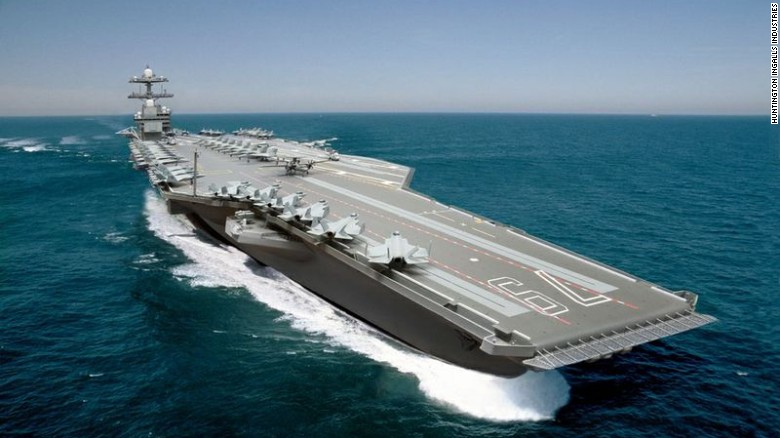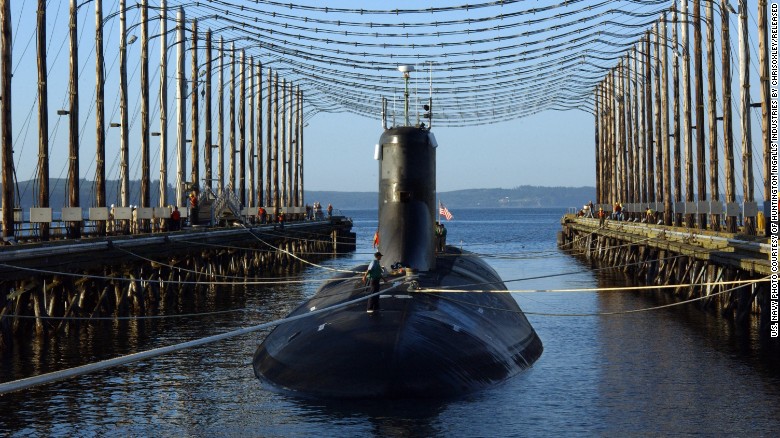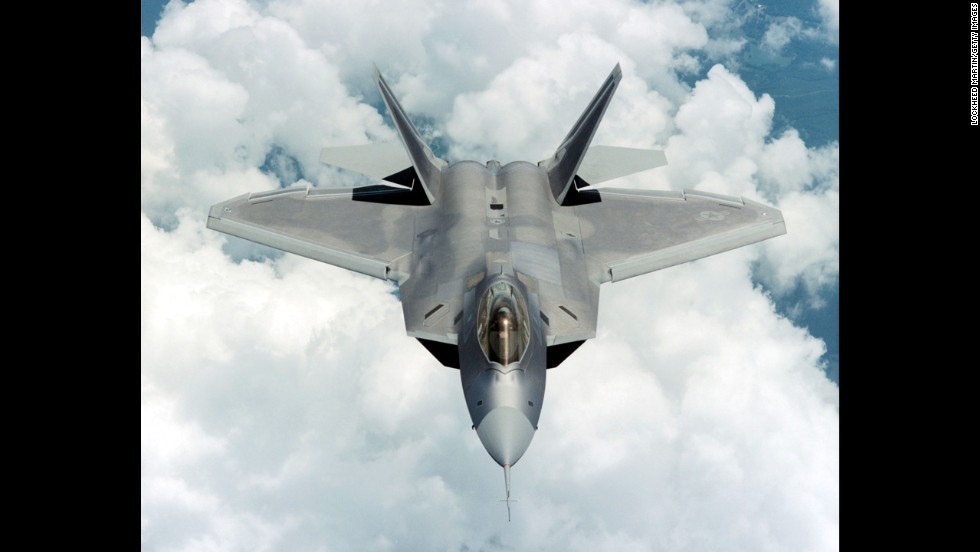Zarvan
ELITE MEMBER

- Joined
- Apr 28, 2011
- Messages
- 54,463
- Reaction score
- 87
- Country
- Location

(CNN)For decades, the United States has had the world's largest and most advanced naval fleet, positioning ships and aircraft carriers in strategic locations across the globe to protect national interests and facilitate free trade.
But as rival nations, such as China and Russia, expand their own naval capabilities, and with China's increasingly aggressive posture in the South China Sea, GOP presidential candidates are warning voters that America's dominance of the world's oceans could end unless lawmakers add significantly more ships to its arsenal to bring the fleet size closer to historic levels.
Former military officials and defense experts, however, say that weighing the current size of the Navy against past ship levels is a misleading comparison that misses the broader point: making sure the Navy is capable of achieving U.S. strategic goals, which depend as much on technological capability and force deployment as the raw number of ships. While many analysts think the Navy needs to grow, others think it's large enough -- given its global dominance -- and that funding realities mean there's a limit to how much it could expand in any case.
That hasn't stopped the expansion of the Navy from becoming a favorite Republican talking point.
Outlining his policy on China in Charleston, South Carolina, Sen. Marco Rubio of Florida warned, "Our Navy is now smaller than at any time since before World War I."
In the first Republican debate last month, neurosurgeon Ben Carson similarly declared, "Our Navy is the smallest it's been since 1917."
Wisconsin Gov. Scott Walker in April compared the current number of ships to that under President Ronald Reagan, telling the New Hampshire Republican Leadership Summit, "We're headed down toward 250. That's less than half of where we were under Reagan."
The U.S. naval force is currently made up of 273 ships, which is the smallest number since the fleet stood at 245 ships in 1916. While fleet size has fluctuated significantly throughout history, topping out at 6,768 during World War II, today's Navy is only slightly smaller than it was in 2006 under President George W. Bush, when it employed 281 active ships.
But former military officials say comparisons between the Navy of 1917 and today's are an apples-to-oranges contrast. The modern Navy includes 10 aircraft carriers -- more than the rest of the world combined -- 90 surface warfare vessels and 72 submarines.
"It is a useful bumper sticker," said Dakota Wood, a former U.S. Marine and senior research fellow for defense programs at the Heritage Foundation. "It resonates with people but doesn't go into the details."
And those details, he continued, make the comparison off base.
"Modern ships are much more capable than the ones 100 years ago. They have better radars and better missile systems," he said, though he noted that other nations' naval capabilities have also evolved.
Rather than comparing ship numbers to those of past fleets, Peter Singer of the New America Foundation said candidates should be more concerned with outlining a naval strategy that reflects the threat environment of today's world.
Calling the line about the smallest Navy "a pretty weak one," Singer said better questions about the future of the Navy would be, "What types of ships are they going to be and how are you going to pay for them?"
The foundation of the U.S. Navy's current strategic posture is based on maintaining what it calls a "forward presence," or an ability to deploy and station forces far from American shores by using international waters and a network of allies to maneuver its assets as needed.

Balancing war-fighting readiness with the fiscal challenges resulting from budget cuts, or sequestration, is a harsh reality for the U.S. Navy.
Despite enjoying technological advantages over rival nations and an increasing ability to base forces close to key strategic regions, in places like Guam, Japan and Spain, Navy officials say they will need more ships in order to effectively and efficiently carry out mission goals going forward.
"A smaller force, driven by additional budget cuts or sequestration, would require us to make hard choices," according to a Navy report on force structure submitted to Congress in March.
The Navy would face increased levels of risk for some missions and functions and a decrease in its forward presence and would have to reduce its footprint in some geographic regions, the report stated. "Such cuts would also limit our war-fighting advantages."
With plans to send approximately 60% of its ships and aircraft to the Indo-Asia-Pacific region by 2020, the Navy says it needs to add roughly 30 ships -- including an additional aircraft carrier and several amphibious vessels -- in order to maintain a consistent presence in other regions around the world.
By adding more ships to its fleet and working with allies to position those ships closer to potential conflict regions, the Navy's top brass says it will be able to maximize the efficiency of its forces while minimizing maintenance costs and reducing the length of deployments.
However, Republican hopefuls -- including Rubio, Carson, Walker, Ohio Gov. John Kasich, Louisiana Gov. Bobby Jindal and others -- insist that the U.S. must "rebuild" and "reinvigorate" the Navy by raising its ship count to as high as 350, a project that would likely cost hundreds of billions of dollars.
Kasich recently listed "renewing the Navy" as his second-highest priority in a CNN op-ed on national security.
"Those who mistakenly think they can deny access to a corner of the globe -- particularly in the Western Pacific or Persian Gulf -- need another visit from a carrier battle group to remind them that the global commons are, in fact, just that: shared real estate," he wrote.
Jindal has made a similar case. Addressing the American Enterprise Institute in 2014, Jindal warned that looming budget cuts would allow China to surpass the size of the U.S. fleet and inhibit America's ability to employ a global Navy.
"The consequences of this foolish, nearly trillion-dollar cut over the coming decade (is) unacceptable. Under these cuts, America will not have a global Navy anymore," he said.
Report: Women could be allowed into Navy SEALs
How much does fleet size matter?
Many defense experts and lawmakers do agree that today's Navy needs more ships in order to respond to emerging threats around the world and to maintain its global presence, with some even suggesting numbers close to those called for by GOP candidates.
Of the 273 deployable ships currently at the Navy's disposal, roughly 85 are at sea at a given time -- a ratio, some argue, that's wearing down U.S. ships and service members. This fall, the U.S. won't have an aircraft carrier stationed in the Persian Gulf for at least two months due to a mix of budget cuts and maintenance needs.
Despite Navy leaders' confidence that their proposal for a 308-ship fleet sufficiently addresses these concerns, some experts say even more ships are needed.
Jerry Hendrix, a retired Navy captain and senior fellow at the Center for a New American Security, agreed with the Republican view that the Navy needs to have closer to 355 ships to maintain current deployment patterns and to carry out missions ranging from disaster relief to military deterrence.
He said that adding more ships to the fleet's rotation would allow the Navy to shorten deployments, which would help personnel retention and avoid carrier gaps in the future.
However, not everyone thinks that the U.S. Navy needs more ships.
Gregg Easterbrook, a journalist who has tracked fiscal policy and military strategy for Reuters and The Atlantic, argued that the U.S. Navy's technological superiority makes it plenty big enough to maintain the dominance it has enjoyed for the last half-century
"The U.S. Navy is 10 times stronger than all of the other world's navies combined," Easterbrook said. "To say that the Navy is weak because the numbers are going down is classic political nonsense."
And Easterbrook said the fact that the U.S. has two Ford-class carriers -- the most advanced aircraft carriers ever built -- currently under construction is evidence that its Navy is still far more technologically advanced than that of any other nation, even if Russia and China have made advances.
"No other country is even contemplating building something like the Ford-class carrier," Easterbrook said. "We could cut the Navy in half in terms of ship numbers and still be far stronger than the rest of the world combined."
To some lawmakers, size is beside the point.
"I don't care if the Navy is bigger or smaller than it was in 1917 or any given year," said Rep. Randy Forbes, R-Virginia, chairman of the House Armed Services Sea Power and Projection Forces subcommittee.
"I just want a Navy that's big enough to keep doing the incredibly important things we need it to do. Looking at the present-day statistics, I can tell you we are not there now -- and the situation is getting worse," he said.
Specifically, Forbes said the Navy is currently being overtaxed by the demands of maintaining a continuous, stabilizing presence overseas.
"When you look at the 10-month-long deployments, the carrier gaps coming up in the Middle East and the Pacific, or the fact that the Marines are considering deploying on foreign ships, it is difficult to escape the conclusion that our Navy is being stretched too thin," he said.
While Republican candidates on the campaign trail have been quick to endorse the idea of increasing the size of the Navy, many experts say the reality of building significantly more ships is easier said than done.
Looming spending caps resulting from 2011's bipartisan budget negotiation will limit next year's military budget to $499 billion, which lawmakers on both sides of the aisle agree is billions short of what's needed to build up such capacity.
Hendrix recognizes that budget constraints may force lawmakers to make tough choices in terms of how they spend tax dollars.
"We are going to have to spend our money in a more intelligent fashion by buying more of the ships we can afford and perhaps less of the ones that are very expensive," Hendrix said.
The U.S. currently maintains a naval strategy centered on aircraft carriers in order to deploy ships and aircraft to various locations in response to potential threats, according to Hendrix.

However, considering the price tag of nearly $14 billion each, Hendrix said building more aircraft carriers might not be a realistic strategy going forward. Instead, he suggested using allies' territory to station more modest ships and troops closer to strategic areas, as well as outfitting less expensive ships and unmanned vessels.
Singer said America's naval strength should be based not purely on the number of ships it has but on whether or not its size fits strategic goals.
"What I want to hear from a candidate (is), what's your vision? What should the Navy's role in the Pacific be? What are your thoughts on the South China Sea?" he said. "It's not the exact number of ships that matters."
Aircraft carrier gets test drive after tune-up

Is the U.S. Navy too small? - CNNPolitics.com
@Horus @Oscar @Jango @Jungibaaz @C130 @Ceylal @Rashid Mahmood @fatman17 @Manticore @nair @SpArK @AUz @Areesh @syedali73 @TankMan @Slav Defence @Abu Zolfiqar @MilSpec @AUSTERLITZ @Gufi









